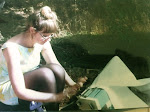This is a short piece of writing that I made to accompany Sundari Carmody's Longboard Sequence installation as part of CACSA Contemporary 2015 at SASA Gallery.
You have been watching me for a long time. I have a beautiful body and you have never before seen a beautiful body like mine. And if you watch me for long enough, you might completely disappear.¹
Like dancing, Sundari Carmody’s forward movement through space in Longboard Sequence is an act of moving through an emotional landscape. The character that she plays is a body afflicted by feeling. It is a feeling that has come to flesh; a simple feeling embodied in a complex movement of limbs and skin and organs, inside a shimmering dress. She is solemn and she feels it in her body, using the action as a way to more deeply understand. It is a ritual for sensation, an emotional rhythm, a fleshy loop. The swing of the leather tassels, the pulse of the pole against the ground, the eternal turn of the black on black wheels act as a refrain within a song about feelings/emotions/loss.
The willful ending of the sequence suggests an endpoint, a destination. But, the endpoint is just a signal to return to the beginning (as in much video art, displayed on an infinite loop). Through repetition, the body’s gestures are abstracted. When the sequence loops back to the beginning, and plays out the series of movements again, it becomes a disorganization of time, a passage of sensation rather than a forward movement. ‘It is no longer a spatial or organized image of time, but time as the power of imaging’² and so Carmody removes it from having any need for interpretation or meaning, and places the movement squarely within the realm of sensation.
Carmody’s solemnity creates within the film a sense of purposefulness and simultaneously, illusiveness. As if she is working towards something, but we are not to know what it may be. My own feelings aboutLongboard Sequence are seasoned by loss. What does it mean to sit with a feeling? What does my body do? What are my rhythms, my refrains? What rituals do I build as a way to create cycles of beginnings and endings- that acknowledge the end, and loss, as a part of my understanding and experience of time? I turned to Duras to think poetically about the body (and the rhythm of the body) encapsulated by loss. Duras’s prose is coloured by sadness, her writing folds and unfolds, revealing the way in which our bodies react to feeling and affect (‘Turn away. Walk on. Forget.’ 3).
In Atlantic Man, Duras writes about creating a film to honour the departure of a lover. Filming is a way to both remember and forget, ‘the film will remain like this. Finished. You are at once hidden and present.’4She speaks of memory and remnants and loss and finding essences, lapses and gaps. Time skips and pulses, her lover is present, but her loss co-exists within the same duration. Narrative is less present in Carmody’s film, but, like Duras, her purpose is to create space for sensation. The character marks out actions for feelings, creating images of mesmerizing intensity.
Beauty, solemnity, the shimmer of the dress.
Longboard Sequence, 2015
custom built longboard, hemp-silk and cotton lawn dress, custom leather shoes by BB Shoemaker, brass tipped Tasmanian oak pole with leather grip and tassel, brass brackets and fittings. Longboard Sequence (video), 2015documentation of an actionsingle channel HD video,16:9, colour2 minutes 3 seconds
http://www.sundaricarmody.com/
NOTES
¹Daniel Kok, in Lisa Havilah, 2009, What I Think About When I Think About Dancing, Campbelltown Arts Centre, Sydney, p127
²Claire Colebrook, 2002, Understanding Deleuze, Allen and Unwin, Sydney, p159
3Marguerite Duras, 1993, Two By Duras, Translated by Alberto Manguel, Coach House Press, Toronto
4ibid
¹Daniel Kok, in Lisa Havilah, 2009, What I Think About When I Think About Dancing, Campbelltown Arts Centre, Sydney, p127
²Claire Colebrook, 2002, Understanding Deleuze, Allen and Unwin, Sydney, p159
3Marguerite Duras, 1993, Two By Duras, Translated by Alberto Manguel, Coach House Press, Toronto
4ibid




No comments:
Post a Comment